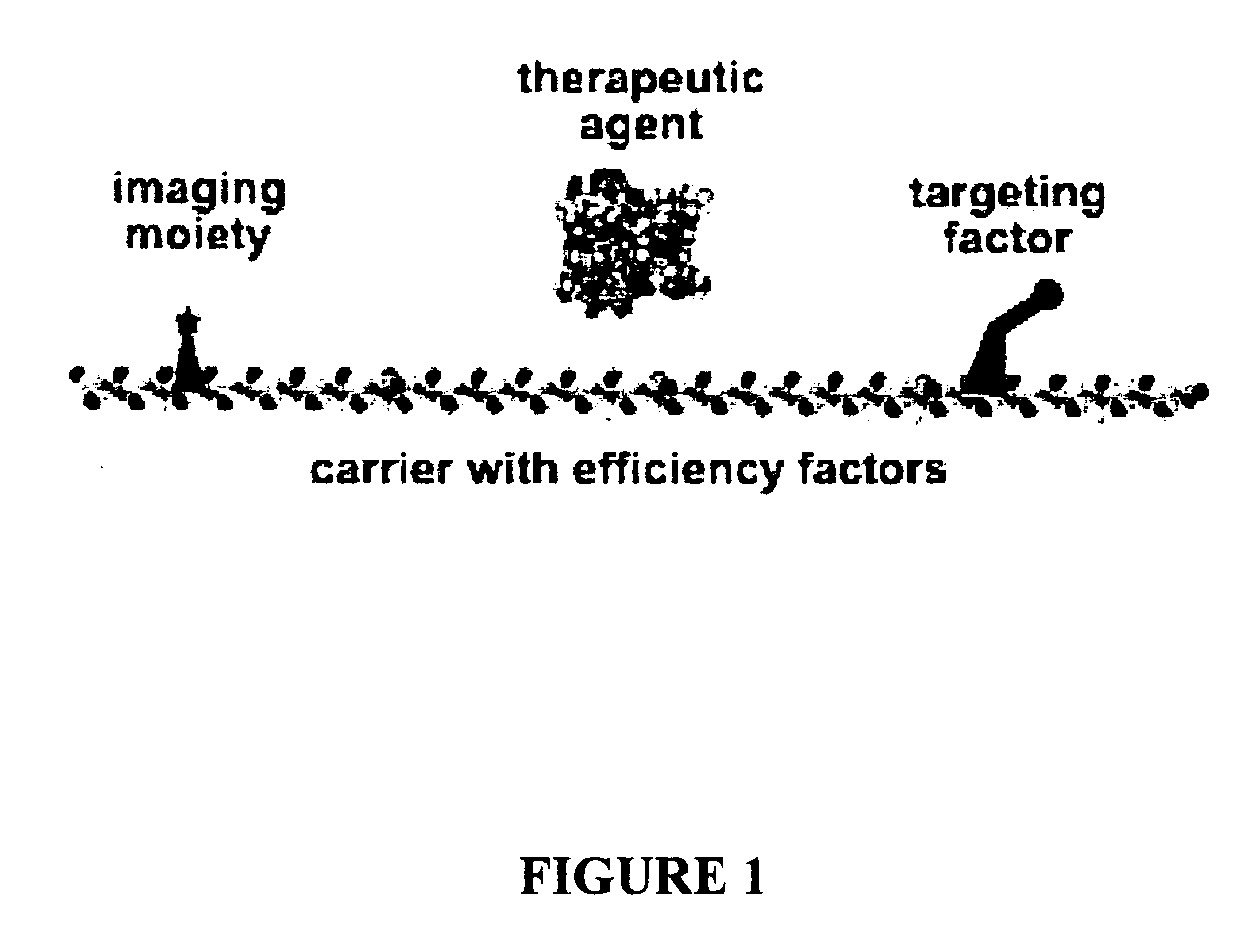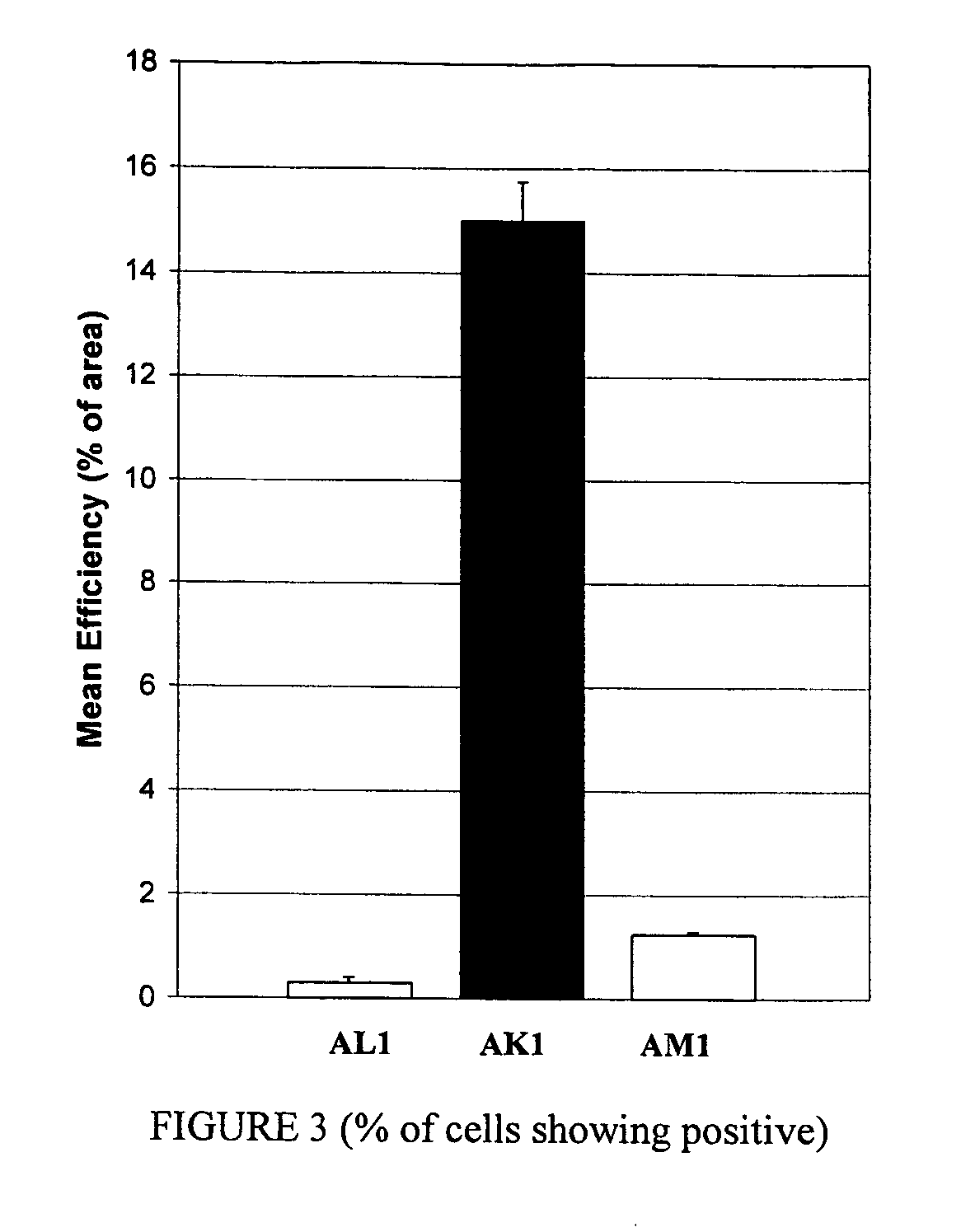Compositions and methods for topical diagnostic and therapeutic transport
a technology of diagnostic and therapeutic transport and compositions, applied in the direction of drug compositions, peptides, enzymology, etc., can solve the problems of skin dryness, adverse side effects, and treatment can be uncomfortable,
- Summary
- Abstract
- Description
- Claims
- Application Information
AI Technical Summary
Problems solved by technology
Method used
Image
Examples
example 1
[0145] This example illustrates transdermal delivery of a very large complex, namely a plasmid containing the blue fluorescent protein (BFP) transgene, using a positively charged backbone or carrier of the invention.
Backbone Selection:
[0146] The positively charged backbone was assembled by covalently attaching -Gly3Arg7 to polylysine MW 150,000 via the carboxyl of the terminal glycine to free amines of the lysine sidechains at a degree of saturation of 18% (i.e., 18 out of each 100 lysine residues is covalently attached to a -Gly3Arg7). The modified backbone was designated “KNR2” to denote a second size of the peptidyl carrier. The control polycation was unmodified polylysine (designated “K2”, Sigma Chemical Co., St. Louis, Mo.) of the same size and from the same lot. An additional control polycation, Superfect® (Qiagen) which is an activated dendrimer-based agent, was selected as a reference for high in vitro transfection rates (i.e. simultaneous positive control and reference f...
example 2
[0177] This example illustrates the transport of a large nucleotide across skin by a carrier of the invention after a single administration.
Backbone Selection:
[0178] The positively charged backbone was assembled by covalently attaching -Gly3Arg7 to polylysine (MW 150,000) via the carboxyl of the terminal glycine to free amines of the lysine sidechains at a degree of saturation of 18% (i.e., 18 out of each 100 lysine residues is covalently attached to a -Gly3Arg7). The modified backbone was designated “KNR2” as before. The control polycation was unmodified polylysine (designated “K2”, Sigma Chemical Co., St. Louis, Mo.) of the same size and from the same lot. An additional control polycation, Superfect (Qiagen) which is an activated dendrimer-based agent, was selected as a reference for high transfection rates (i.e. simultaneous positive control and reference for state-of-the art efficiency versus toxicity in vitro).
Therapeutic Agent selection:
[0179] For the present experiment,...
example 3
[0190] This example illustrates the transdermal delivery of a large nucleotide-based therapeutic across skin using a positively charged peptidyl carrier of the invention in seven sequential daily applications.
Backbone Selection:
[0191] The positively charged peptidyl backbone was assembled by covalently attaching -Gly3Arg7 to polylysine (MW 150,000) via the carboxyl of the terminal glycine to free amines of the lysine sidechains at a degree of saturation of 18% (i.e., 18 out of each 100 lysine residues is covalently attached to a -Gly3Arg7). The modified backbone was designated “KNR2”. The control polycation was unmodified polylysine (designated “K2”, Sigma Chemical Co., St. Louis, Mo.) of the same size and from the same lot.
Therapeutic agent selection:
[0192] For the present experiment, an 8.5 kilobase plasmid (pSport-based template, Gibco BRL, Gaithersburg, Md.) containing the entire transgene for E. Coli beta-galactosidase (βgal) and partial flanking sequences driven by a cyt...
PUM
| Property | Measurement | Unit |
|---|---|---|
| weight % | aaaaa | aaaaa |
| non-covalent | aaaaa | aaaaa |
| anatomic structures | aaaaa | aaaaa |
Abstract
Description
Claims
Application Information
 Login to View More
Login to View More - R&D
- Intellectual Property
- Life Sciences
- Materials
- Tech Scout
- Unparalleled Data Quality
- Higher Quality Content
- 60% Fewer Hallucinations
Browse by: Latest US Patents, China's latest patents, Technical Efficacy Thesaurus, Application Domain, Technology Topic, Popular Technical Reports.
© 2025 PatSnap. All rights reserved.Legal|Privacy policy|Modern Slavery Act Transparency Statement|Sitemap|About US| Contact US: help@patsnap.com



